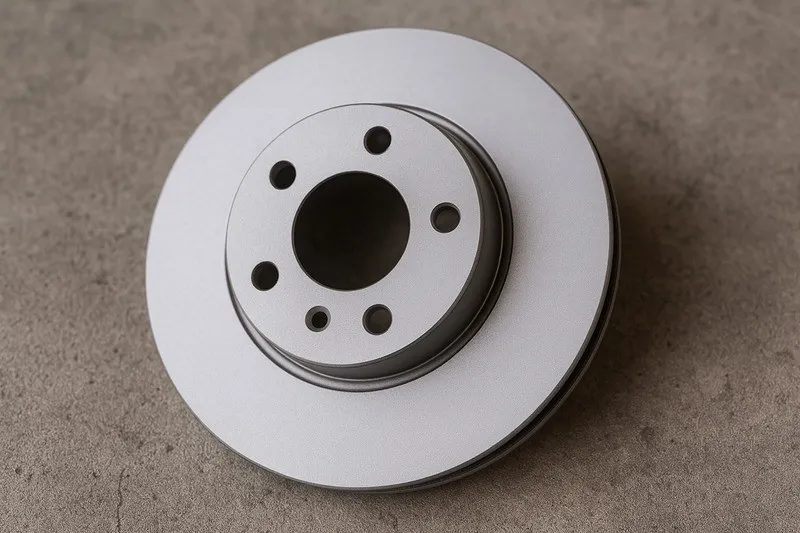Why You Should Consider Plain Coated Rotors Over Drilled and Slotted
April 01, 2025In our blog we already compared different types of rotors (plain vs coated vs drilled and slotted), but got quite a few questions like "Should I buy the most expensive drilled and slotted". Let's compare one more time, but in this article we will highlight why you should not get drilled and slotted rotors.
Marketing vs. Practical Use
Drilled and slotted rotors look like they belong on a track car. For many people, the aesthetic alone can justify the extra price. They are heavily marketed as high-performance options, with claims that they improve braking power, dissipate heat better, and help eliminate brake fade. While some of this is true under very specific conditions, it doesn't always translate to daily driving or even spirited weekend drives.
What often gets lost in the conversation is that these features are intended for high-speed, high-temperature environments, such as track racing, where extreme braking forces are constantly applied. For your daily commute or even aggressive street driving, plain coated rotors often outperform them in terms of reliability, longevity, and overall value.
Cracking and Warping Risk
The holes in drilled rotors act as stress risers. Under repeated heat cycles and pressure, these holes can cause premature cracking. The slots, while helping with gas and dust evacuation, also remove some material and can create uneven wear patterns on the brake pads. Combined, this increases the likelihood of rotor warping over time—something every car owner wants to avoid.
Plain rotors, especially coated ones, avoid these structural weaknesses. Because they are a solid piece of material, they handle thermal expansion more uniformly. This gives them an advantage when it comes to resisting warping and cracking under normal operating conditions.
Brake Pad Wear and Noise
Drilled and slotted rotors are harsher on brake pads. The sharp edges of the holes and slots act like sandpaper, wearing down pads faster. This means more frequent replacements and higher long-term costs. They can also introduce noise and vibration during braking, which might be misinterpreted as a problem with your braking system.
With plain coated rotors, braking is quieter and smoother. Pad life is extended, and wear patterns remain more predictable. This helps with consistent braking performance and reduces the number of shop visits.
Weather Protection: Coated vs. Uncoated
One major advantage that doesn’t get enough attention is the protective coating found on many modern plain rotors. These coatings help fight rust and corrosion, particularly in regions with high humidity or where roads are salted in the winter. Drilled and slotted rotors often don’t come coated, or if they do, the coating wears off faster due to increased surface area and friction points.
The protective layer on coated rotors ensures that even if you're not driving every day, your rotors aren’t deteriorating. It also makes them easier to maintain, with less surface rust buildup that can lead to uneven pad contact or vibration.
Cost vs. Benefit Analysis
Drilled and slotted rotors often cost 30–70% more than plain coated rotors. Now ask yourself: do you truly get 30–70% more performance over lifespan? For the average driver, the answer is almost always no. You’re paying for a look and features designed for extreme situations that most vehicles never experience.
Plain coated rotors strike the right balance between performance, durability, and cost. They give you reliable stopping power, resist corrosion, and extend the life of your brake pads, all without overcomplicating your brake system or introducing unnecessary risks.
When Are Drilled and Slotted Actually Useful?
There’s a time and place for drilled and slotted rotors: performance track use, heavy towing, or specialized off-road applications. If you participate in track days where you're pushing your car to its limits repeatedly, the added cooling and dust shedding capabilities of these rotors can make a difference.
But if your driving habits include a mix of city and highway travel, occasional road trips, and maybe a mountain drive here and there, plain coated rotors will likely serve you better. They’ll last longer, cost less, and perform more consistently across typical driving conditions.
Installation and Maintenance
Another advantage of plain coated rotors is that they’re easier to install. There’s no directional requirement, and you don’t have to align slots or holes. It’s straightforward and reduces the chance of installation errors. Plus, they’re easier to clean, which makes maintenance simpler if you work on your own car.
Coated rotors are usually “ready to install” out of the box, with no need to degrease them. The coating burns off cleanly during your initial brake-in period, leaving your friction surface pristine and ready for use.
Final Thoughts
Drilled and slotted rotors may look cool and sound impressive in product descriptions, but for most drivers, they are overkill. The added cost, faster pad wear, and potential for cracking often outweigh the minimal benefits they provide outside of a racing environment.
Plain coated rotors, on the other hand, offer everything most drivers need: durability, consistent braking, rust protection, and a smoother driving experience. Unless you have a very specific reason to go with drilled and slotted, consider sticking with a high-quality set of plain coated rotors. Your car, and your wallet will thank you.
If you found this helpful, feel free to browse our other brake component breakdowns and comparisons to make the most informed decision possible for your vehicle.


